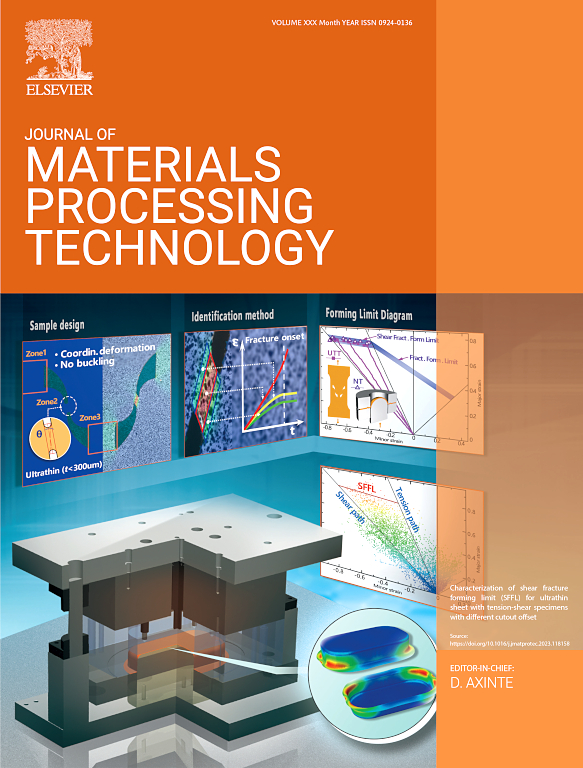A comprehensive analytical model for tensile-bending straightening in strip processing by coupling residual stress and buckling deformation
IF 6.7
2区 材料科学
Q1 ENGINEERING, INDUSTRIAL
Journal of Materials Processing Technology
Pub Date : 2025-03-14
DOI:10.1016/j.jmatprotec.2025.118802
引用次数: 0
Abstract
Tensile-bending straightening machines improve strip quality by optimizing the residual stress distribution within the strip and eliminating plate defects. Straightening involves multiple roller groups and various initial defect shapes. However, previous research has mainly focused on single roller group analyses and finite element models. These approaches cannot fully address the entire straightening process for strips with initial defects, hindering their practical application and reducing straightening accuracy. Therefore, this paper proposes for the first time an analytical mechanistic model for the whole process of strip tensile-bending straightening. Elastoplastic mechanics and symplectic geometry mechanics were applied to reveal the complete mechanism of the stress changes from the initial defect to straightening. First, an offline "coordinated-uncoordinated-recoordinated" model is proposed, providing a universal residual stress formula that is adaptable to various defect types. Second, unlike traditional methods, the Hamiltonian approach is used to derive critical buckling load solutions for defective strips. Furthermore, based on pre-straightening residual stress and compressive layer plastic deformation, a comprehensive analytical model is developed to encompass the stress distribution, evolution, buckling, and mechanical changes during straightening. The analytical model predictions closely matched three-dimensional finite element simulation results, outperforming traditional methods in accuracy and efficiency. The model is applicable for various strip defects, enabling the straightening parameters to be optimized, bridging the gap between traditional assumptions and practical applications, and offering precise control, with broad applicability and potential.
基于残余应力和屈曲变形耦合的带材拉伸-弯曲矫直综合分析模型
拉伸弯曲矫直机通过优化带材内部的残余应力分布和消除板材缺陷来提高带材质量。矫直涉及多个辊组和各种初始缺陷形状。然而,以往的研究主要集中在单辊群分析和有限元模型上。这些方法不能完全解决具有初始缺陷的带钢的整个矫直过程,阻碍了它们的实际应用,降低了矫直精度。因此,本文首次提出了钢带拉伸-弯曲矫直全过程的解析机理模型。应用弹塑性力学和辛几何力学揭示了从初始缺陷到矫直过程中应力变化的完整机理。首先,提出了离线“协调-非协调-重协调”模型,提供了适用于各种缺陷类型的通用残余应力公式;其次,与传统方法不同,哈密顿方法用于导出缺陷带材的临界屈曲载荷解。基于矫直前残余应力和压缩层塑性变形,建立了包含矫直过程中应力分布、演化、屈曲和力学变化的综合分析模型。分析模型预测结果与三维有限元模拟结果吻合较好,在精度和效率上优于传统方法。该模型适用于各种带钢缺陷,可以优化矫直参数,缩小传统假设与实际应用之间的差距,实现精确控制,具有广泛的适用性和潜力。
本文章由计算机程序翻译,如有差异,请以英文原文为准。
求助全文
约1分钟内获得全文
求助全文
来源期刊

Journal of Materials Processing Technology
工程技术-材料科学:综合
CiteScore
12.60
自引率
4.80%
发文量
403
审稿时长
29 days
期刊介绍:
The Journal of Materials Processing Technology covers the processing techniques used in manufacturing components from metals and other materials. The journal aims to publish full research papers of original, significant and rigorous work and so to contribute to increased production efficiency and improved component performance.
Areas of interest to the journal include:
• Casting, forming and machining
• Additive processing and joining technologies
• The evolution of material properties under the specific conditions met in manufacturing processes
• Surface engineering when it relates specifically to a manufacturing process
• Design and behavior of equipment and tools.
 求助内容:
求助内容: 应助结果提醒方式:
应助结果提醒方式:


